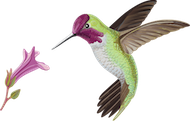Here is a perfect example of how we, and wildlife, benefit from native pollinators. In early summer our prickly pear cactus plants flower and insects are immediately attracted to them. Among those insects will be bees in the tribe known as Eucerini , or Longhorn Bees.
Longhorn Bees, not European Honeybees, are the primary pollinators of the Garden’s cactus flowers. We have two different species of regularly occurring Longhorn Bees in the GNG (Melissodes sp. and Synhalonia sp.). The individuals in the video above are in the Genus Melissodes. It's easy to tell the sexes apart because the male's antennae are more than twice the length of the female's. The male's lengthy antennae is where the name "Longhorn" derives from.
Once pollinated, the flower will fall off the plant and a fruit will begin to grow. The two green "prickly pears" growing from the pad will take a few months to ripen. The one remaining flower is being visited by a male Melissodes bee.
By early November the fruit is a deep crimson red, indicating it's ripe and ready to be harvested. Susan is carefully collecting some prickly pears for an afternoon snack. But before we eat them, their spines will need to be removed.

After singeing off the spines over an open flame, the fruit is ready eat - another delicious benefit of having a robust, healthy and thriving native garden ecosystem!
And even though we partake in tasting many plants that grow in the garden, we are always respectful and a leave a bounty for the wildlife.

